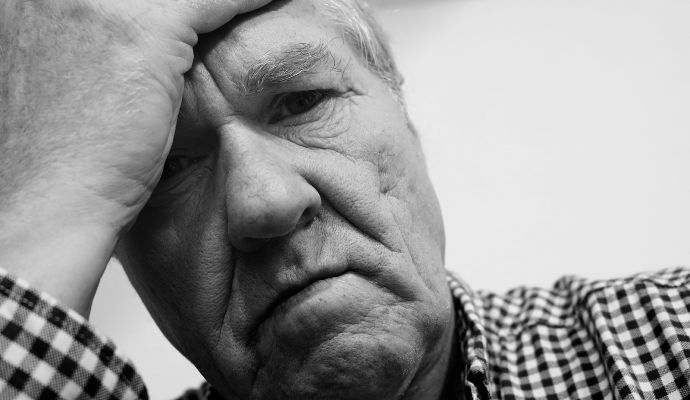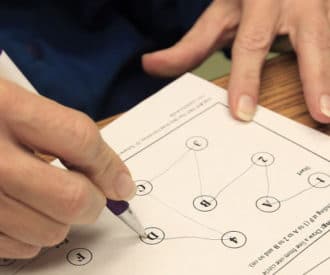
Pain in dementia isn’t always obvious or easy to diagnose
Seniors with dementia often experience pain or serious discomfort on a regular basis.
Typically, their pain is caused by health conditions common among older people, like arthritis, constipation, recovery from surgery or medical procedures, injuries due to falls or accidents, infections, or pressure sores.
However, it’s not always easy to know when someone with dementia is in pain.
That’s because their ability to recognize what’s going on in their body and communicate their needs declines as dementia advances.
Also, the non-verbal ways they use to communicate pain is often not what we’d expect, so it’s easy to miss or misinterpret those signals.
We share 3 reasons why you might not know if someone with dementia is in pain, 5 common causes of pain in dementia, 3 ways to find out if someone is in pain, and 2 ways to treat chronic pain.
3 reasons why it’s challenging to detect pain in seniors with dementia
1. Inability to describe, explain, recognize, or remember pain
One reason we don’t know when someone with dementia is in pain is that they lose the ability to recognize or describe what’s happening with their body.
Even when asked specifically, they may not be able to explain how they’re feeling, where the pain is, when it started, how it feels, etc.
And even though they feel and are affected by it, they may not be able to recognize that what they’re feeling is pain.
Plus, if someone has problems with short-term memory, they may have forgotten about an episode of pain.
However, that doesn’t mean that they weren’t affected by the pain at the time or that they won’t be in pain again.
2. Fear
Another reason someone with dementia may not say when they’re in pain is that they’re afraid.
They might be afraid that they would need surgery or a painful treatment, be sent to the hospital or a nursing home, or be given medication they don’t want.
3. Pride
Even if they can clearly communicate their thoughts and feelings, some people may have grown up with the belief that pain is to be endured silently.
Their pride tells them that people should never admit to or complain of pain.
Others may think that admitting to being in pain and needing help means that they’ll lose respect or independence.
5 common causes of pain in dementia
Alzheimer’s disease or dementia itself doesn’t typically cause physical pain, but there are many health conditions that commonly affect older adults that do cause significant pain.
1. Chronic health conditions
Painful chronic conditions like arthritis, gout, diabetic neuropathy, and others are common among seniors. These all cause ongoing pain, sometimes severe.
2. Injuries and surgery
Injuries from falls can cause pain – even if there are no visible bruises.
Plus, if you weren’t there at the moment and they didn’t remember to tell you, you may not even know that they’ve recently fallen.
After surgery, older bodies often take longer to recover. So even if we think someone is fully recovered, they may still be healing and in significant pain.
3. Infections and illness
Common infections like urinary tract infections (UTIs) can also cause pain and significant discomfort.
Other common illnesses like shingles can be very painful and take months or years to fully recover from.
4. Other common conditions
Everyday issues can also cause significant pain and discomfort.
Conditions like constipation, upset stomach, acid reflux, etc. are common in older adults as the digestive system slows with age.
5. Bed sores
If someone has limited mobility, they’re at risk for developing bed sores (aka pressure sores). These can progress quickly and become extremely painful.
3 ways to find out if someone with dementia is in pain
1. Ask them directly
The first thing to do is ask directly if they’re in pain. Many people are able to provide information on their pain.
It's important to keep the questions simple and remember that someone may not understand what the word “pain” means.
You may need to ask questions like “Is it sore here?” or “Does it hurt?” or even pointing and saying “Ouch?”
It’s also important to remember that if someone has poor short-term memory, they might only know if they’re in pain at that moment.
They may not remember if they were in pain five minutes, five hours, or a day ago.
Finding out how severe the pain is might be a challenge because they may not be able to describe what they’re feeling.
If someone isn’t able to describe or express their pain, don’t pressure them. Asking repeatedly might cause them to become agitated, angry, or upset.
2. Know the person well
Being familiar with your older adult’s typical behavior helps you recognize signs that they’re in pain, discomfort, or distress.
For one person it could be uncharacteristic angry outbursts, for someone else it might be unusually quiet and withdrawn behavior.
To recognize signs of pain, think about their typical mood and behavior, body posture and movement, and if they usually return to expected behavior after taking pain medication (a sign that they’re feeling better).
And, be sure to consider known medical conditions as possible causes for chronic pain.
For example, arthritis, ulcers, pressure sores, recent surgery, old or new injuries, a history of constipation, chest pain, migraines, or headaches are ongoing conditions that still cause pain even if someone loses the ability to let others know it’s happening.
3. Observe their behavior
Challenging behavior can often be a sign that someone is in pain.
Examples include:
- Making sounds like whimpering or groaning
- Showing facial expressions like frowning, grimacing, or looking frightened or tense
- Guarding certain parts of their body
- Crying or calling out
- Rocking
- Refusing to eat
- Being angry, aggressive, or combative or clenching fists
- Being especially quiet or withdrawing from activities
- Being difficult to please or inconsolable
- Showing increased confusion
- Having higher than normal heart rate or blood pressure, labored breathing
- Sweating, looking flushed (blotchy, reddened skin), or looking very pale
- Pacing or wandering
- Being restless
- Repeating behaviors or words
2 ways to relieve chronic pain
1. Try a variety of non-drug pain relief treatments
Non-drug ways to relieve chronic pain can make a big difference. They can be used alone or in combination with pain relief medication.
Each person’s body is different, so it may take some experimenting or combinations of treatments to find what works best.
Non-drug pain relief ideas include:
- Gentle exercise or massage to loosen stiff joints and tight muscles
- Heating pads or cold packs – be sure to avoid direct contact to protect fragile older skin
- Changing position – sitting or lying in different positions and using pillows or pads to support the body
- Using gel or air cushions to relieve pressure
- Distracting with pleasant activities like listening to music, spending time with family and friends, pet therapy, reading or listening to audiobooks, arts and crafts, etc.
- Making their environment more calm, soothing, and comfortable
- Using over the counter pain relief creams like Ben Gay, Biofreeze, Icy Hot, or others
2. Talk with the doctor about appropriate medications
Controlling pain is essential for quality of life and in many situations, pain relief medication is needed in addition to non-drug treatments.
If you’ve ruled out other potential causes for challenging or unusual behavior and suspect that your older adult is experiencing pain on a regular basis, it’s a good idea to talk with their doctor about medication to manage their pain.
Before adding pain medication (even an over-the-counter one), it’s essential to speak with the doctor to make sure that it won’t cause problems with any other medications they’re already taking regularly.
For many people, over-the-counter pain medication may be all that’s needed.
When strong prescription pain medication is necessary, many families are concerned about the risk of addiction.
If the doctor thinks the medication is appropriate for the condition, don’t let that worry stop your older adult from getting the pain relief they need. Drug-seeking behavior isn’t common in people with dementia.
Other types of medications to relieve pain include antibiotics to treat infection, laxatives to relieve constipation, and antacids to help indigestion.
Some doctors may prescribe or recommend medications on an “as needed” basis instead of a regular daily dose. This only works well with someone who is consistently able to recognize signs of pain and ask for their medication.
With pain in dementia, the person doesn’t have that ability.
So, when you know the pain is chronic (like with arthritis), talk with the doctor to find out if a regular daily dose can be prescribed to make sure your older adult’s pain is consistently under control.
Recommended for you:
- How to Understand and Manage Dementia Behaviors: A Comprehensive Guide
- 14 Ways to Calm Dementia Screaming and Crying
- How to Deal with Caregiver Guilt in Dementia: 6 Tips
By DailyCaring Editorial Team
Image: From the Harp
This article wasn't sponsored, but does contain affiliate links. We never link to products or services for the sole purpose of making a commission. Recommendations are based on our honest opinions. For more information, see How We Make Money.
[optin-monster slug=”yxbytm35zhsdfopnw7qk”][optin-monster slug=”jvhyplxmb4umsjazxecn”]
About the Author

Connie Chow
Connie was a hands-on caregiver for her grandmother for 20 years. (Grandma made it to 101 years old!) She knows how challenging, overwhelming, and all-consuming caring for an older adult can be. She also knows how important support is — especially in the form of practical solutions, valuable resources, and self-care tips.




